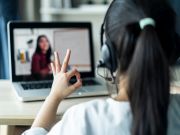Pandemic Learning Can Strain Children's Eyes

THURSDAY, Aug. 27, 2020 (HealthDay News) -- If your child will be doing online learning this school year, you need to take steps to protect them from eye strain, the American Academy of Ophthalmology says.
"I really have seen a marked increase in kids suffering from eye strain because of increased screen time. Good news is most symptoms can be avoided by taking a few simple steps," pediatric ophthalmologist Dr. Stephen Lipsky, a clinical spokesperson for the academy, said in an academy news release.
Here he offers these remote-learning recommendations to protect your child's vision:
- Set a timer to remind your child to take a break every 20 minutes. Alternate reading on an e-book with a real book. Encourage children to look up and out the window every two chapters or to shut their eyes for 20 seconds.
- Mark books with paperclips every few chapters. When they reach a paper clip, it will remind them look up. On an e-book, use the bookmark function for the same effect.
- Make sure children use laptops at arm's length (about 18 to 24 inches) from where they're sitting. Ideally, they should have a monitor positioned at eye level, directly in front of the body. Tablets should also be held at arm's length.
- To reduce glare, position the light source behind the child's back, not behind the screen. Adjust the brightness and contrast on the screen so that it feels comfortable for children. Don't use a device outside or in brightly lit areas. The glare on the screen can cause eye strain.
- Children shouldn't use a device in a dark room. As the pupil expands to adjust to the darkness, the brightness of the screen can aggravate after-images and cause discomfort.
- Children should stop using devices 30 to 60 minutes before bedtime. Blue light may disrupt sleep. If teens don't want to do this, have them switch to night mode or a similar mode to reduce blue light exposure.
When study time is over, make sure children spend time outdoors. Several studies suggest that spending time outdoors, especially in early childhood, can slow the progression of nearsightedness.
More information
The U.S. Centers for Disease Control and Prevention offers a checklist for returning to school during the pandemic.

The news stories provided in Health News and our Health-E News Newsletter are a service of the nationally syndicated HealthDay® news and information company. Stories refer to national trends and breaking health news, and are not necessarily indicative of or always supported by our facility and providers. This information is provided for informational and educational purposes only, and is not intended to be a substitute for medical advice, diagnosis, or treatment.

